NH Snow Cover Extent
| October 2018 | Snow Cover Extent | Anomaly 1991-2020 | Trend per decade | Rank (51 years) | Record | ||||||
|---|---|---|---|---|---|---|---|---|---|---|---|
| million km² | million mi² | million km² | million mi² | million km² | million mi² | Year(s) | million km² | million mi² | |||
| Northern Hemisphere | 20.06 | 7.75 | +0.89 | +0.34 | +0.38 | +0.15 | Largest | 14th | 1976 | 25.72 | 9.93 |
| Smallest | 38th | 1988 | 12.78 | 4.93 | |||||||
| North America | 9.67 | 3.73 | +1.19 | +0.46 | +0.15 | +0.06 | Largest | 2nd | 2002 | 9.76 | 3.77 |
| Smallest | 50th | 1979 | 6.36 | 2.46 | |||||||
| Eurasia | 10.39 | 4.01 | -0.29 | -0.11 | +0.23 | +0.09 | Largest | 22nd | 1976 | 17.22 | 6.65 |
| Smallest | 30th | 1988 | 5.58 | 2.15 | |||||||
Data Source: Global Snow Laboratory, Rutgers University. Period of record: 1967–2018 (51 years)
The Northern Hemisphere snow cover extent (SCE) for October 2018 was 20.06 million square km (7.74 million square miles), which was 2.52 million square km (970,000 square miles), or 14.4 percent, larger than the 1981-2010 average. This was the 14th largest October SCE in the 51-year period of record for the Northern Hemisphere. Each of the last seven Octobers, beginning with October 2012, has seen above-average Northern Hemisphere SCE values. Despite the above-average monthly SCE, this was the smallest October value since 2011. October's long term trend (since 1967) is +2.1% more SCE per decade, the largest such upward trend of any month.
The October North American SCE was 9.67 million square km (3.73 million square miles), 1.62 million square km (620,000 square miles) above average and the second largest on record. Only the October SCE in 2002 was larger. This is also the seventh consecutive October with above average North American SCE. Snow cover was above average for northern, central, and eastern areas of Canada as well as parts of the north-central United States. The Canadian SCE was the largest on record for October. Below-average snow cover was observed from Alaska through western Canada into the Northern U.S. Rockies. The contiguous U.S. SCE was near-average while the Alaskan SCE was the third lowest on record.
The Eurasian SCE during October was 10.39 million square km (4.01 million square miles), which is 890,000 square km (34,000 square miles) above average. This ranked near the median value in the 51-year period of record. Above-average snow cover stretched from Scandinavia to central Russia, across western Russia to northern China and Mongolia, as well as parts of the Tibetan Plateau. Below-average snow cover was observed across Far East and central Russia and in the Himalayas.
Sea Ice Extent
| October 2018 | Sea Ice Extent | Anomaly 1991-2020 | Trend per decade | Rank (40 years) | Record | ||||
|---|---|---|---|---|---|---|---|---|---|
| million km² | million mi² | Year(s) | million km² | million mi² | |||||
| Northern Hemisphere | 6.13 | 2.37 | -18.16% | -10.28% | Largest | 37th | 1986 | 9.48 | 3.66 |
| Smallest | 4th | 2012 | 5.89 | 2.27 | |||||
| Southern Hemisphere | 17.73 | 6.85 | -2.74% | +0.66% | Largest | 36th | 2013 | 19.02 | 7.34 |
| Smallest | 5th | 1986 | 17.18 | 6.63 | |||||
| Ties: 2001 | |||||||||
| Globe | 23.86 | 9.21 | -7.23% | -2.53% | Largest | 39th | 1980 | 27.75 | 10.71 |
| Smallest | 2nd | 2016 | 23.54 | 9.09 | |||||
Data Source: National Snow and Ice Data Center (NSIDC). Period of record: 1979–2018 (40 years)
According to the National Snow and Ice Data Center (NSIDC), the Northern Hemisphere (Arctic) sea ice extent — which is measured from passive microwave instruments onboard NOAA satellites — averaged for October 2018 was 6.06 million square km (2.34 million square miles), 2.29 million square km (880,000 square miles), or 27.4 percent, below the 1981-2010 average. This was the third smallest October Arctic sea ice extent on record. Only the October Arctic sea ice extent in 2007 and 2012 were smaller. Sea ice expanded at a slower than average rate in early October and approached near-record low levels on the daily scale. The rate of expansion sped up during the second half of the month. Regionally, ice expanded rapidly in the Beaufort and Chukchi Seas, but overall ice coverage remained below average. Ice growth was also slow with below-average ice coverage in the Laptev and the Barents Seas. Since 1979, October Arctic sea ice extent is decreasing at an average rate of 9.2 percent per decade.
The October Southern Hemisphere (Antarctic) sea ice extent was 17.66 million square km (6.82 million square miles), which was 440,000 square km (170,000 square miles), or 2.43 percent, below the 1981-2010 average. This was the fourth smallest October Southern Hemisphere sea ice extent on record. Below-average ice coverage was observed south of Australia and South Africa and in the Bellingshausen and Amundsen Seas. Southern Hemisphere October sea ice extent is increasing at an average rate of 0.6 percent per decade. On October 2nd, the Antarctic sea ice extent reached its annual maximum extent at 18.15 million square km (7.01 million square miles). This was the fourth smallest Antarctic sea ice extent maximum on record.
For further information on the Northern and Southern Hemisphere snow and ice conditions, please visit the NSIDC News page.
 NOAA's National Centers for Environmental Information
NOAA's National Centers for Environmental Information




